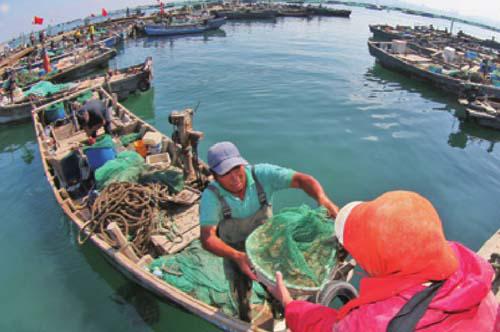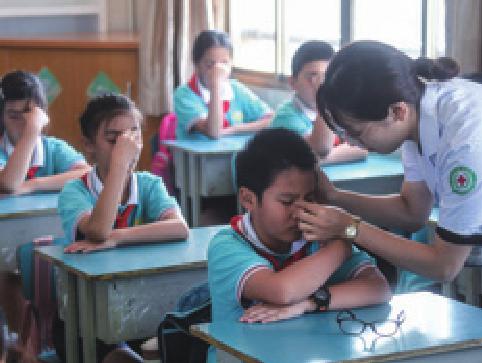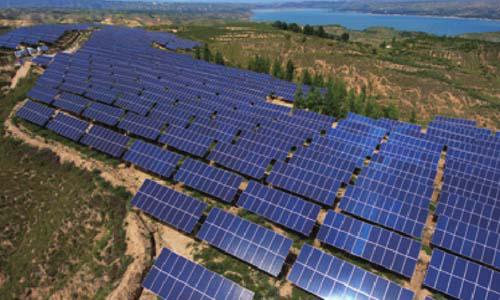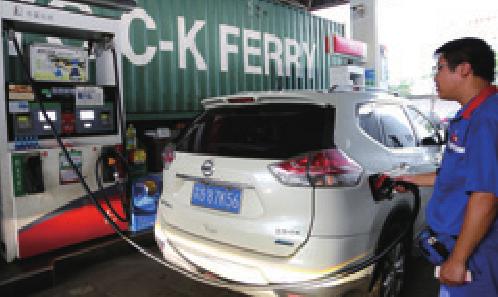Seafood Season
2018-10-18

A fisherman carries shrimp to shore at the Dongkou fishing port on Zhifu Island in Yantai, east Chinas Shandong Province, on September 1. The 2018 summer fishing ban on the Yellow and Bohai seas, which began on May 1, ended on that day.
Out of Poverty
China lifted 740 million people in rural areas out of poverty from 1978 to 2017, roughly 19 million each year, the National Bureau of Statistics (NBS) said on September 3.
The poverty ratio in rural areas dropped 94.4 percentage points during the period with an average annual decrease of 2.4 percentage points, according to the NBS.
The data shows that Chinas poverty relief achievements have contributed more than 70 percent to global poverty alleviation work over the past 40 years.
The average annual income of rural residents in impoverished areas rose an average of 10.4 percent each year from 2012 to 2017, up 2.5 percentage points from the average.
Over the past five years, over 68 million people were lifted out of poverty in China. The country aims to further lift 10 million people out of poverty this year and eradicate poverty by 2020.
China recently released guidelines on winning the battle against poverty in the next three years in order to prepare the nation for eradicating poverty by 2020.
In China, people whose annual income is less than 2,300 yuan($337.3) are defined as living below the poverty line.
Civil Aviation Soaring
China has 32 civil airports with annual passenger throughput reaching the 10-million level, the China Civil Airports Association said on September 3.
“The civil aviation industry plays an important role in boosting Chinas economic and social development,”said Li Xiaomei, Secretary General of the association.
Li made the remarks at a press conference on the 2018 China Airport Development Conference and Exhibition, scheduled for September 12-13 in Changsha in central Chinas Hunan Province.
The event is jointly sponsored by the association, the Changsha Municipal Government and the International Air Transport Association (IATA), with a focus on the latest technologies in airport safety, operational control, security and intelligent information.
As of June, China had 232 airports for civil aviation use.
“Alongside Chinas reform and opening up, civil airports have made great progress in management, planning layout, safety and size,”said Li.
“Both new technology and innovative management contribute to this progress, creating huge market value and opportunities at home and abroad,” Li added.
In 2017, Chinas civil aviation passenger volume reached 552 million, a 13-percent increase year on year.
IATA forecasted China will surpass the United States as the worlds largest civil aviation market by 2022.
Cheaper Cancer Drugs
Chinese patients will be able to buy 14 kinds of cancer drugs at a lower price beginning in September, according to Chinas state medical insurance administration.
The National Healthcare Security Administration has lowered the procurement prices of these cancer drugs, asking pharmaceutical companies to submit price adjustment applications to provincial-level drug procurement offices, according to a recent circular issued by the administration.
It has also selected a range of drugs for further negotiations to be included on the countrys medical insurance reimbursement list.
The drugs are all crucial for dealing with hematological neoplasms and solid tumors, and have great clinical value and huge benefits for patients, the administration said.
Soil Pollution Prevention
Chinas top legislature passed a law on soil pollution prevention and control on August 31, as the country escalates its fight against pollution.
The law was adopted after the third reading at a session of the National Peoples Congress (NPC)Standing Committee that ran from August 27 to 31.
The new law filled the legal void on soil protection and will go into effect on January 1, 2019.
National standards for soil pollution risk control will be set by the environmental authority of the State Council based on the soils contamination status and public health and ecological risks, according to the law.
The legislation also stated that a nationwide soil condition census should be conducted at least once every 10 years.
A network of monitoring stations should be established nationwide, with data and other information collected shared among authorities in environmental, agricultural, natural resources, housing, water resources, health and forestry and grassland sectors, it said.
Ride-Hailing Safety
Chinese regulators began a safety overhaul of the countrys ride-hailing and car-pooling service providers on September 5.
Within half a month, a multidepartment inspection team, including supervisors from the Ministry of Transport, will examine the industrys eight major players including Didi Chuxing for safety loopholes and problems concerning the safety of passengers and the public at large.
The team began its in-house inspection on September 5 at Didi, which had been ordered by authorities to rectify its operation to ensure the safety of its services after the murder of a second passenger this year.
Liu Xiaoming, Vice Minister of Transport and head of the inspection team, told Didi to fully cooperate with the inspection and be responsible to the people.
Didi announced a safety rectification plan on September 4, suspending its late-night ride-hailing service from September 8 to 15 on the Chinese mainland and introducing key safety initiatives, including adding a one-click Call Police function, to its application.
Inspectors will also see if regulatory authorities have lived up to their responsibilities and will propose punishment for those found in dereliction of duty, as well as the enterprises and executives confirmed of violating laws or regulations.
Other online ride-hailing and car-pooling firms will be inspected by local authorities under the guidance of provincial-level transport authorities during the campaign.
Easy on the Eyes
A teacher shows a student how to do eye exercises in a primary school in Donglin Township of Huzhou City, east Chinas Zhejiang Province, on September 4. The classes aim to popularize knowledge about eye protection as China looks to curb the rise in myopia among children and teens.
Fighting Gang Crime
Central authorities have launched the first round of inspections on a national crackdown on gang crime. From August 27 to September 1, nine inspection teams were deployed to nine provincial-level regions including Shanxi, Fujian, Guangdong, Chongqing and Sichuan.
Meetings were also held in the nine regions, responding to public concerns which were highlighted as priorities for the authorities. Leads concerning criminal gangs should be checked in time, and major cases should be transferred by law to relevant departments.
The meetings also urged the cracking of the “protective umbrellas” surrounding gangs with zero tolerance.
Each inspection will last one month. Telephone hotlines, as well as post office boxes and e-mails, have been set up to accept public complaints on local gang-related activities. The sources of the complaints will be strictly protected.
The inspection of a national crackdown on gang crime consists of three rounds, with each round covering 10 provincial-level regions.
Joy of Harvest
A farmer dries corn in the sun in Matou Town of Tancheng County in Linyi, east Chinas Shandong Province, August 30.
PMI Increase
Chinas factory and service activities picked up in August, adding to signs that the economy is showing resilience amid government measures to bolster the real economy.
The countrys manufacturing purchasing managers index (PMI) came in at 51.3, accelerating from 51.2 in July, the National Bureau of Statistics (NBS) said on August 31.
A reading above 50 indicates expansion, while a reading below reflects contraction.
The figure beat market expectations of about 51, mainly driven by the notably higher industrial product prices, said investment banking firm China International Capital Corp. in a research note.
In August, the input and output price sub-indices jumped to 58.7 and 54.3, respectively, from 54.3 and 50.5 in July, indicating that the yet-to-be- released producer price index for August could exceed expectations, according to investment bank Nomura.
Augusts reading was flat, with an average reading of 51.3 for the first eight months of the year, according to NBS senior statistician Zhao Qinghe.
“Production continued to expand while market demand remained generally stable,” Zhao said.
The sub-index for production rose to 53.3 from 53 in July while the sub-index for new orders edged down from 52.3 in July to 52.2.
Data also showed that Chinas non-manufacturing sector expanded at a faster pace, with the PMI for the sector standing at 54.2 in August, up from 54 in July.
The service sector, which accounts for more than half of the countrys GDP, registered fast growth, with the sub-index measuring business activity in the industry standing at 53.4, up from 53 in July.
Rapid expansion was seen in industries including air and railway transportation, retail and telecommunications, the NBS said.
Data came in amid looming concerns over a slowdown in the Chinese economy as investment growth showed signs of softening while external uncertainties remained.
Authorities have pledged coordinated efforts and policies to stabilize employment, finance, foreign trade, foreign investment, investment and expectations, with measures such as tax cuts and cheaper financing to support the real economy.
A State Council executive meeting on August 30 announced new measures that are expected to reduce the tax burden on businesses by more than 45 billion yuan ($6.58 billion) this year.

Sunshine Power
A photovoltaic power plant in Loufan County, Taiyuan City, north Chinas Shanxi Province. In recent years, the county has vigorously developed solar energy by building photovoltaic power plants on bare mountains.
China-Japan Dialogue
China and Japan agreed on August 31 to step up financial cooperation amid rising economic headwinds and market vulnerabilities due to trade friction from U.S. President Donald Trumps protectionist measures, top officials from both sides said.
As the top two Asian economies,“China and Japan have agreed to deepen regional fiscal and financial cooperation and maintain economic and financial stability” as they face growing threats from unilateralism and protectionism, Minister of Finance Liu Kun said at a news briefing in Beijing after the seventh China-Japan Finance Dialogue.
Liu said that he held fruitful discussions with Japans Deputy Prime Minister and Finance Minister Taro Aso that outlined clear steps for the next stage of cooperation between the two sides.
“We agreed to support multilateralism and maintain an open global economic stance against unilateralism and protectionism, and jointly maintain free trade and economic globalization under the framework of the G20 and 10+3 (ASEAN plus China, Japan and South Korea) multilateral mechanisms,” said Liu.
At the dialogue, delegates from both countries discussed several issues such as budget and public debt management and tax reforms. They agreed that fiscal policy plays an important role in coping with financial risks and supporting economic development.
This was also the first time that delegates from both countries central banks and financial regulatory institutions were in attendance, discussing financial cooperation in many areas. They reached several agreements on further opening up financial markets and enhancing bilateral financial regulatory cooperation.
Finance ministries of the two countries also jointly issued a research report on pension fund reform, and decided to continue to study important issues together in the future.
“The mood was extremely positive,” said Aso. “We have noticed the influences from developed countriesfinancial policy normalization, along with interest rate hikes. Asset prices have become more volatile.”
China and Japan must strengthen bilateral cooperation under the multilateral frameworks of the G20 and 10+3, to proactively cope with challenges, he said. “The consolidated relationship between the two countries is very important.”
Kids and Robots
Children watch robot wrestling at the 17th China International Equipment Manufacturing Exposition in Shenyang, northeast Chinas Liaoning Province, on September 2.
Stock Connect
The China Securities Regulatory Commission (CSRC) on August 31 issued draft rules on depositary receipt businesses in the ShanghaiLondon stock connect program for public feedback.
The forthcoming program aims to allow stocks listed in Shanghai and London to be traded in each others market by issuing depositary receipts.
The draft rules detailed procedures and requirements including the approval system for the issuance of China Depositary Receipts (CDRs), the continued regulation on CDRs and regulation on Chinese companies issuing Global Depositary Receipts (GDRs) in overseas markets. China will make active preparations for launching the ShanghaiLondon stock connect program within the year, the CSRC said earlier in August.
Huawei-OSN Collaboration
Chinese tech giant Huawei announced on September 4 that it will join forces with the United Arab Emirates-based Orbit Showtime Network (OSN) to offer Internet TV services in the Middle East.
Huawei has signed a memorandum of understanding (MoU) with OSN, the leading entertainment network in the Middle East, to offer the Internet Protocol Television(IPTV) service, the company said in a statement.
“We hope this MoU will strengthen the digital video ecosystem in the region and we look forward to continuing to grow this industry in the Middle East,” said Sun Xiaofeng, Vice President of Huawei Middle East.
Neil Martin, Chief Commercial Officer of OSN, said that Middle East and North Africa telecom operators will have access to an agile end-toend IPTV solution which will enable them to provide faster service to customers and maximize their revenues.
Its collaboration with Huawei is part of OSNs digitization strategy to enhance product delivery by utilizing innovative technologies.
The partnership brings together OSNs wide array of entertainment content and Huaweis world-class video cloud solution.
Fueling Up
An attendant refuels a car at a gas station in Lianyungang, east Chinas Jiangsu Province, on September 3.
China raised the retail prices of gasoline and diesel on September 4. Retail prices went up by 180 yuan ($26.32) per ton for gasoline and 170 yuan($24.86) for diesel.

New Cargo Line
SF Airlines, the aviation branch of Chinas courier SF Express, opened a new direct all-cargo air route on September 4 linking Shenzhen in south Chinas Guangdong Province with Singapore.
The new cargo route will be operated by B767-300 cargo freighters, and represents the companys latest step in expanding its international network and enhancing its global presence, according to SF Airlines.
It came after the airline opened a direct cargo route between Shenzhen and Chennai in south India on August 5.
“The opening of new international cargo routes shows our capacity to quickly respond to market demand and serve our customers with a competitive network,” said Liang Xi, SF AirlinesVice President of Maintenance and Engineering.
Shenzhen-based SF Airlines currently has the countrys largest allfreighter fleet with 47 planes.
The cargo airline focuses on providing air express and customized air freight services for SF Express. It has transported around 2 million tons of cargo since its launch in 2009.
China has a surging air express industry. In 2017, the country transported 7.06 million tons of airmail cargo, a 5.6-percent increase year on year, according to statistics from the Civil Aviation Administration of China.
